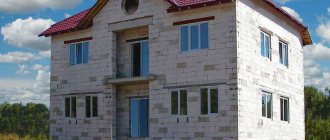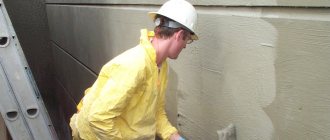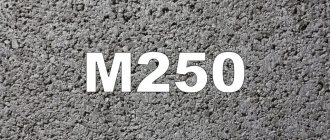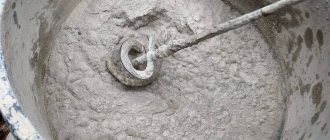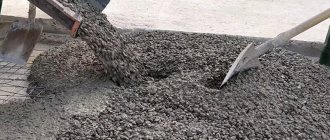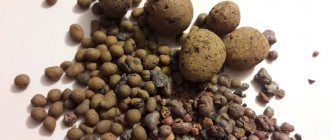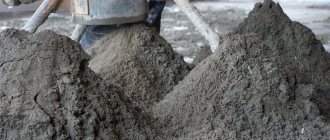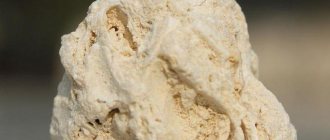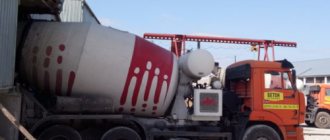Share:
21 Jan
| see prices for concrete B 25 order concrete B 25 Call!; |
Today, class B25 concrete is considered the most popular material in industrial and commercial construction. The reason for this was the tightening of design requirements. Which is understandable, because even in comparison with B22.5, the closest “neighbor” in class, B25 concrete exceeds it in strength characteristics by more than 50 kgf/sq.cm.
Concrete mortar M350
Heavy concrete M350 is a popular building material, corresponding to strength class B25 according to GOST 26633-2015 and C20/25 according to the European classification. The material is used for the construction of all types of monolithic foundations, columns, load-bearing floors, as well as for the installation of industrial floors. Solution M 350 is used for the production of reinforced concrete products. After gaining strength, B25 concrete is able to withstand loads of up to 325 kg/cm2 for a long time. In liquid form, concrete mixture M350 has the following characteristics:
- workability P1…P4;
- average density - 2500 kg/m3;
- hardness - Zh1...Zh4;
- water holding capacity – average
- air entrainment is low.
The weight of the concrete solution depends on the characteristics of the coarse aggregate - the main component that is added to the mixture. Depending on the type of aggregate, the mass of 1 cubic meter of the mixture can be 1700-5000 kg, depending on the density of the aggregates.
Practice of using concrete B25
As for the practice of using B25 concrete, we strongly do not recommend resorting to making the mixture directly on the construction site, despite the cheapness and convenience of this method. First of all, because in this way it is impossible to achieve compliance of the physical and technical parameters of the mixture with the design grade of concrete. It is even more difficult to determine “by eye” the degree of workability of the finished mixture and its suitability for pouring into formwork. And recommendations to “add water” to improve the mobility of the mixture are absolutely unacceptable in this case - changing the water-cement ratio will lower the grade of concrete, which will negatively affect the strength of the material. In a factory environment, the product is subjected to quality control more than once, starting with testing of raw materials and ending with experimental control of mobility indicators. A batch of concrete is released to the client only if the characteristics of the concrete, B25 or any other grade, fully comply with GOST. At the same time, the quality certificate for concrete indicates not only the strength class, but also the aggregates used, additives, indicators of mobility, water resistance and frost resistance.
sells factory-produced concrete, guaranteeing customers:
- Branded product that meets GOST requirements;
- Use of high-quality raw materials in mixtures;
- Fast delivery of concrete to construction sites in Moscow and the Moscow region;
- Reasonable prices for concrete and transportation;
- Extensive list of additional building materials.
Do you want to clarify the nuances? Our specialists are at your service by phone, email or in person.
Components of concrete M350
The composition of concrete mortar B25 (C20/25) includes cement, sand, crushed stone or other coarse filler, and water. Portland cement grade M400 or M500 is used as a cement binder. The use of Portland slag cement is permitted upon agreement with the consumer of the concrete mixture.
To mix the material, fillers with the following density are used:
- crushed stone from sedimentary rocks GOST 8267-93 - 2500-2800 kg/m3;
- gravel from sedimentary rocks GOST 8267-93 - from 2200 kg/m3;
- ferroalloy-slag crushed stone GOST 5578-94 - 400-1600 kg/m3
- crushed stone from thermal power plant slag GOST00-1100 kg/m3;
- crushed concrete GOST 32495-2013 - 2000 kg/m3;
- limonite - 2080-2400 kg/m3;
- barite - 2320-2560 kg/m3;
- goethite - 2080-2240 kg/m3;
- ilmenite - 2560-2700 kg/m3;
- magnetite - 2400-3040 kg/m3;
- ferrophosphorus - 3200-4160 kg/m3;
- iron scale - 3860-4650 kg/m3.
The mass of 1 cubic meter of M350 concrete solution depends on the type and density of coarse aggregate.
Laying rules
Laying SUB
During the installation of SUB, the following recommendations should be taken into account:
- It is necessary to ensure a continuous supply of material to the installation site. Make sure that after unloading the solution from one mixer, begin emptying the next one.
- Strictly control the time of delivery of material to the construction site.
- Before pouring concrete, you must ensure that there is no water in the formwork. The presence of excess water can cause delamination.
- The length of the pipeline for pumping the solution should be no more than 200 m (see photo).
Concrete pump pipeline
- Concrete supplied through pipelines does not require additional compaction.
- Concreting thin-walled building structures, where independent removal of air bubbles is difficult due to technical conditions (formwork of complex geometric shapes, columns of small diameter), the solution must be supplied through the lower pipe of the frame formwork.
Self-compacting concrete mixtures are materials with unique physical and mechanical properties. Their production became possible thanks to the combined use of highly effective superplasticizers and active mineral additives.
Proportions of concrete M350 (B25)
Ready-mix concrete M350 at mortar-concrete units and construction sites is mixed with crushed granite or gravel. Ratio of main components when mixing:
- Portland cement M400 - 1 hour;
- sand - 1.5 hours;
- crushed stone - 3.1 hours;
- water - 0.5 tsp.
When using high-strength cement M500, the proportions will be as follows:
- Portland cement M400 - 1 hour;
- sand - 1.9 hours;
- crushed stone - 3.6 hours;
- water - 0.5 tsp.
The selection of the composition of heavy concrete of class B25 is carried out according to GOST 27006-2019 in accordance with the technical specifications and taking into account the required technical and operational characteristics.
How to influence density (volumetric weight)
The density of this material most depends on the properties of the components of the solution
That is why they need to be selected with special attention, so that the result is a material of the required density. This material parameter is influenced by many aspects
To obtain a solution of the required density you need:
- Use the smallest filler available. Thanks to this, it is possible to reduce the number of voids in reinforced concrete products.
- Reduce the amount of water. But it must be taken into account that the mobility of the solution must be normal. It is difficult to work with thick and heavy mortar, in particular when pouring complex-shaped and large-sized structures.
- Compact the solution mechanically or manually. Compacted with vibrators or fittings.
- Artificial heating of the poured mixture. This allows moisture to evaporate faster, thereby increasing the mass and density of the material.
- Choose expanding or non-shrinking cement. For example, you can use aluminous cement or Portland cement. Thanks to this, the material will have little porosity, and its quality will not deteriorate.
- Use of plasticizers. Additives allow you to reduce the amount of water required to make the solution and maintain its mobility. Thanks to this, it will be possible to increase the density of the material.
- Vacuuming. This technological process is quite complex, so it is used only in industrial production.
How much does 1 cube of M350 concrete weigh?
To prepare 1 cubic meter of concrete mix M 350 using M400 cement and granite/gravel crushed stone you will need:
- 393.5 kg of cement;
- 590.2 kg of sand;
- 1219.7 kg of crushed stone;
- 196.7 kg of water.
When using high-quality cement M500, the number of components in the recipe changes slightly:
- 342.8 kg of cement;
- 651.4 kg of sand;
- 1234.3 kg of crushed stone;
- 171.4 kg of water.
The mass of 1 cubic meter of solution is 2400 kg. The weight of concrete must be known to calculate the load capacity of a concrete mixer and lifting equipment when lifting mortar in buckets to a height is required.
Concrete composition tables.
| No. | Name of components | Number of components | Concrete density kg/m3 | Concrete grade kg/m3 | Brand of hollow stone kg/m3 |
| Concrete on sand and crushed stone. | |||||
| 1 | Cement. kg Sand quartz m3 (kg) Water. l. | 240 1.15 (1950) 90…130 | 2200 | 130 | 80 |
| 2 | Cement. kg Sand quartz. m3 (kg) Dolomite or limestone crushed stone. m3 (kg) Water. l | 200 0.54 (920) 0.65 (980) 90…130 | 2100 | 150 | 90 |
| 3 | Cement. kg Dolomite or limestone screenings. m3 (kg) Dolomite or limestone crushed stone. m3 (kg) Water. l | 200 0.3 (450) 0.8 (1200) 90…130 | 1900 | 130 | 75 |
| 4 | Cement. kg Dolomite or limestone screenings. m3 (kg) Water. l | 200 1.1 (1650) 90…130 | 1900 | 85 | 50 |
| 5 | Cement. kg Sand quartz.. m3 (kg) Crushed granite. m3 (kg) Water. l Acceptable option - 2 Cement. kg Sand quartz.. m3 (kg) Crushed granite. m3 (kg) Water. l Or instead of sand and crushed stone - screening crushed stone fraction up to 20 mm | 200 0.54 (920) 0.65 (1100) 90…130 170-220 0.54 (920) 0.65 (1100) 90…130 | 2300 from 2000 | 170 to 170 | 100 from 75 Density of the Stone as a whole 1650 |
| Concrete on waste brick | |||||
| 6 | Cement. kg Clay scrap. or silica. brick fraction 2…15 mm. m3 (kg) Sand quartz.. m (kg) Water. l | 230 0.9 (990) 0.32 (540) 90…130 | 1800 | 100 | 60 |
| LIGHTWEIGHT CONCRETE | |||||
| Expanded clay concrete | |||||
| 7 | Cement. kg Expanded clay. m3 (kg) Water. l | 250 1.2 (720) 100…150 | 1000 | 50 | 30 |
| 8 | Cement. kg Expanded clay fraction. 0…5 mm. m3 (kg) Expanded clay fraction. 5…15 mm. m3 (kg) Water. l | 220 0.65 (390) 0.6 (330) 90…130 | 950 | 90 | 30 |
| Ash concrete | |||||
| 9 | Cement. kg Coal ash or slate. m3 (kg) Water. l | 200 1.2 (960) 90…130 | 1200 | 50 | 30 |
| 10 | Cement. kg Coal or oil shale ash m3 (kg) Sand quartz.. m3 (kg) Water. l | 220 0.9 (720) 0.32 (540) 90…130 | 1500 | 60 | 35 |
| 11 | Cement. kg Dolomite or limestone crushed stone. m3(kg) Coal ash. or shale. m3 (kg) Water. l | 9О…13О 200 0.5 (750) 0.53 (420) 90…130 | 1500 | 120 | 70 |
| Expanded clay concrete | |||||
| 12 | Cement. kg Expanded clay fraction. About...5 mm. m3 (kg) Expanded clay fraction. 5…15 mm. m3 (kg) Coal ash. or slate. m3 (kg) Water. l | 200 0.65 (390) 0.55 (300) 0.44 (350) 90…130 | 950 | 50 | 30 |
| Cinder concrete | |||||
| 13 | Cement. kg Granulated slag. m3 (kg) Water. l | 200 1.3 (720) 90…130 | 950 | 75 | 45 |
| 14 | Cement. kg Granulated slag.. m3 (kg) Quartz sand.. m3 (kg) Water. l | 200 0.9 (500) 0.32 (540) 90…130 | 1250 | 100 | 60 |
| 15 | Cement. kg Boiler slag. m3 (kg) Water. l | 200 1.2 (1080) 90…130 | 1300 | 75 | 45 |
| 16 | Cement. kg Boiler slag. m3 (kg) Sand quartz.. m3 (kg) Water. l | 200 0.8 (720) 0.32 (540) 90…130 | 1450 | 100 | 60 |
| Ash and slag concrete | |||||
| 17 | Cement. kg Boiler slag. m3 (kg) Coal ash. or shale. m3 (kg) Water. l | 200 0.8 (720) 0.4 (720) 90…130 | 1250 | 75 | 45 |
| Sawdust concrete | |||||
| 18 | Cement. kg Sawdust. m3 (kg) Sand quartz.. m3 (kg) Water. l | 260 0.6 (150) 0.65 (!!00) 100…150 | 1500 | 50 | 30 |
| 19 | Cement. kg Sawdust. m3 (kg) Sand quartz.. m3 (kg) Water. l | 280 0.4 (100) 0.8 (1350) 100…150 | 1760 | 70 | 40 |
| 20 | Cement. kg Sawdust. m3 (kg) Quartz sand. m3 (kg) Lime paste. m3 (kg) Water. l | 230 0.9 (220) 0.3 (500) 0.04 (50) 100…150 | 1000 | 50 | 30 |
| Expanded clay sawdust concrete | |||||
| 21 | Cement. kg Kramzit. m3 (kg) Sawdust. m3 (kg) Water. l | 280 0.7 (420) 0.6 (150) 100…150 | 880 | 45 | 25 |
| 22 | Cement. kg Kramzit. m3 (kg) Sawdust. m3 (kg) Sand quartz.. m3 (kg) Water. l | 280 1.1 (600) 0.1 (25) 0.25 (425) 100…150 | 1350 | 60 | 35 |
| Ash-saw concrete | |||||
| 23 | Cement. kg Coal ash or slate. m3 (kg) Sawdust. m3 (kg) Sand quartz.. m3 (kg) Water. l | 230 0.55 (440) 0.6 (150) 0.65 (1100) 100…150 | 1500 | 50 | 30 |
| 24 | Cement. kg Coal ash or slate. m3 (kg) Sawdust. m3 (kg) Sand quartz.. m3 (kg) Water. l | 230 0.06 (50) 0.4 (100) 0.8 (1360) 100…130 | 1750 | 70 | 40 |
| 25 | Cement. kg Coal ash or slate. m3 (kg) Sawdust. m3 (kg) Water. l | 260 0.75 (600) 0.45 (115) 100…150 | 1000 | 60 | 35 |
| Expanded clay zoloopyl concrete | |||||
| 26 | Cement. kg Expanded clay. m3 (kg) Coal ash. or slate. m3 (kg) Sawdust. m3 (kg) Water. l | 220 1.1 (600) 0.045 (40) 0.1 (25) 100…150 | 1300 | 60 | 35 |
| Perlite concrete | |||||
| 27 | Cement. kg Expanded perlite. m3 (kg) Sand quartz.. m3 (kg) Water. l | 280 0.9 (240) 0.4 (680) 100…150 | 1200 | 50 | 30 |
| Polystyrene concrete | |||||
| 28 | Cement. kg Polystyrene granules.. m3 (kg) Quartz sand.. m3 (kg) Water. l | 250 0.4 (27) 0.55 (935) 100…150 | 1250 | 45 | 25 |
| COMPOSITIONS BASED ON GYPSUM | |||||
| Gypsum ash concrete | |||||
| 29 | Gypsum G-5. kg Fly ash from thermal power plants. m3 (kg) Sand quartz.. m3 (kg) Water. l | 320 0.1 (80) 0.75 (1300) 210 | 1700 | 125 | 75 |
| 30 | Gypsum G-5. kg Fly ash from thermal power plants. m3 (kg) Sand quartz.. m3 (kg) Water. l | 380 0.3 (210) 0.55 (950) 260 | 1600 | 110 | 65 |
| Gypsum sawdust concrete | |||||
| 31 | Gypsum G-5. kg Sawdust. m3 (kg) Sand quartz.. m3 (kg) Water. l | 540 0.4 (100) 0.3 (500) 250 | 1150 | 50 | 30 |
| 32 | Gypsum G-5. kg Sawdust. m3 (kg) Granulated slag fraction. About...15 mm. m3 (kg) Water. l | 540 0.4 (100) 0.3 (170) 260 | 850 | 40 | 25 |
| Gypsum clay concrete | |||||
| 33 | Gypsum G-5. kg Expanded clay. fractional About...15 mm. m3 (kg) Water. l | 430 0.8 (500) 270 | 1000 | 70 | 45 |
Weight control of concrete M350
The weight of the material is important when shipping and receiving it. Weight control is carried out as follows:
- The empty mixer machine or container is weighed.
- The mixer or container is loaded with concrete mixture of a given strength class.
- The loaded vehicle or container is weighed.
- The mass of the concrete solution is determined.
- A comparison is made between the nominal and actual mass of the material.
- Knowing the weight of concrete and its grade, conclusions can be drawn about its volume.
Weight control is used when delivering concrete mixture to the buyer, when it is not possible to measure the material by volume. Knowing the volume and weight of the mixture, you can determine its density without a density meter.
Application area
The above characteristics of the B25 concrete grade make its scope very wide.
In particular, it is used for the following purposes:
- For the construction of foundations and other load-bearing structures;
- In the manufacture of floor slabs, beams and columns.
- When pouring road slabs for airfields, etc.
As mentioned above, this material has good water resistance. As a result, builders often use it when filling swimming pool bowls, as well as during the construction of other hydraulic structures.
Advice! If large loads are not planned on the concrete structure, then during its construction you can use concrete of a lower class than B 25. This will allow you to save a little during construction.
Cement M500
Characteristics and influence on the quality of the solution
Specific gravity is related to strength. The higher it is, the higher the strength of the building material.
Porosity
The opposite and inverse value to density, which also characterizes the strength of concrete, is porosity.
How to increase density
You can adjust this parameter knowing the following features:
Step-by-step preparation of concrete
And now about how I prepared M350 concrete. I did this in a bucket, although for full-fledged construction, it is certainly better to use a concrete mixer. But it’s not difficult to work with a small volume and handles:
- Mixed sand and cement thoroughly.
- Added water. Stirred until a homogeneous mixture was obtained.
- Filled with rubble.
- Additives for frost resistance and moisture protection (optional).
- Stir the solution until it is homogeneous.
- Used until it hardened. I have two hours to work. As for me, the solution should be stirred periodically during work - this makes it more convenient to continue using it.
Don't buy concrete! Until you watch THIS! Concrete for building a house and foundation, how to check
The result obtained depends not only on the proportions and the technical process. The ingredients are also important. The purity of water, sand, freshness of cement - all this affects durability and reliability.
Specifications
Construction standards are a set of specific rules and requirements for the design and characteristics of materials and structures. Main technical parameters of concrete B15 according to GOST:
1) Compressive strength. Material of this class is capable of withstanding a load of 200 kg applied per 1 cm² of the surface of a concrete structure.
2) Concrete class is also an indicator of the strength of concrete, but it comprehensively indicates the guaranteed general strength characteristic for the entire structure in MPa (B15). According to SP 27.13330.2011, these markings are valid for designers and builders. To compare two definitions of strength, class-to-grade conversion tables are used.
3) The density of concrete grade M200 (B15) is 1800-2500 kg per cubic meter. This density class is classified as heavy.
4) Frost resistance and water resistance. These technical characteristics are indicated in the design documentation to ensure the reliability of structures. F50, F75, F100, F150, F200, F300, F400, F500 - the numbers determine the durability of structures operating at subzero temperatures. Up to 4 cycles are accepted during the year. W2, W4, W6, W8 and W12 - waterproof cylinder 15 cm at a pressure of 2.4, 6, 8 and 12 kg per cm². For example, concrete B15 F100 with water resistance w4 - class B15, frost resistance of 100 cycles and water resistance with a pressure of at least 4 kg.
5) Mobility and stiffness indicators are indicated by the letter “P”. Values 1 to 5 indicate the time course of the mixture to determine workability. For narrow formwork, a grade of concrete (B15, M200) not lower than P3 is suitable.
Table of reference density values for tree species
Since standardized density values for wood have a group appearance, I had to look through English reference books to collect density values by tree species. The result is the following table:
Wood density of the most common tree species
| Wood species | Wood density kg/m³ |
| Balsa (Balsa) | 120-160 |
| Siberian fir | 390-430 |
| Northern spruce | 400-450 |
| Sequoia evergreen | 410 |
| Poplar | 400-500 |
| Willow | 460 |
| Pine | 450-500 |
| Alder | 490 |
| Aspen | 510 |
| Linden | 530 |
| Red tree | 540 |
| horse chestnut | 560 |
| Edible chestnut | 590 |
| Cypress | 600 |
| Bird cherry | 610 |
| Sapelli | 620 |
| Hazel | 630 |
| Walnut | 640 |
| Birch | 650 |
| Cherry | 660 |
| Smooth elm | 660 |
| Larch | 660 |
| Field maple | 670 |
| Teak | 670 |
| Pear | 690 |
| Oak | 690 |
| Afromosia | 700 |
| Switenia (mahogany) | 700 |
| Sycamore | 700 |
| Zhoster (buckthorn) | 710 |
| Beech | 720 |
| Hornbeam | 750 |
| Paduc | 750 |
| Tiss | 750 |
| Ash | 750 |
| Dussia | 800 |
| Kempas | 800 |
| Plum | 800 |
| Lilac | 800 |
| Hawthorn | 800 |
| Rosewood | 800 — 1000 |
| Pecan (cariah) | 830 |
| Yarra | 830 |
| Merbau | 840 |
| Jatoba (mareil) | 840 |
| Keruing | 850 |
| Kulahi | 850 |
| Turmoil | 850 |
| Wenge | 900 |
| Lapacho | 900 |
| Olive | 900 |
| Sandalwood | 900 |
| Panga-panga | 950 |
| Boxwood | 960 |
| Lim | 970 |
| Sucupira | 1 000 |
| Kumara | 1 100 |
| Ebony (Persimmon) | 1 080 |
| Ebony | 1 160 |
| Quebracho | 1 210 |
| Guaiacum or bakout | 1 280 |
Deformative properties
Under the influence of gravity, concrete mortar behaves completely differently than other materials. The compacted consistency of the concrete solution determines its action during increasing pressure.
Cellular concrete has minimal elasticity properties. The indicators are slightly higher for lightweight porous concrete. The highest level of springiness is found in heavy building materials. The springy properties of concrete can easily be manipulated to adjust the structure of the solution.
Methods for determining strength
In addition, the strength of concrete is determined at the construction site during the work process, which makes it possible to control the quality of the mixture.
Kawabanga! How to calculate the concrete surface modulus and what is the indicator for?
There are two main methods for determining the strength of concrete: destructive and non-destructive. Usually, the strength of concrete at an intermediate age is not determined; most often, already hardened samples or pieces of a monolith are used.
Destructive way
Non-destructive method
This group of methods does not require destruction of samples and may not involve their use at all. Tests are carried out using various tools and devices.
Types of non-destructive research methods by type of tools used:
- Impact
- Partial destruction
- Ultrasound examination
The impact method is based on the application of impact-type force to a concrete surface.
Partial destruction involves a local impact on the concrete monolith and damages it slightly.
